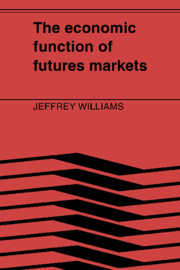Book contents
- Frontmatter
- Contents
- Preface
- 1 An introduction to futures markets
- 2 Equivalent ways to borrow and lend commodities
- 3 Futures markets and risk aversion
- 4 The demand to borrow commodities
- 5 The contribution of futures markets
- 6 The optimal number of futures markets
- 7 Conclusion: The economic function of futures markets
- Glossary of trade terms
- Reference list
- Index
2 - Equivalent ways to borrow and lend commodities
Published online by Cambridge University Press: 06 October 2009
- Frontmatter
- Contents
- Preface
- 1 An introduction to futures markets
- 2 Equivalent ways to borrow and lend commodities
- 3 Futures markets and risk aversion
- 4 The demand to borrow commodities
- 5 The contribution of futures markets
- 6 The optimal number of futures markets
- 7 Conclusion: The economic function of futures markets
- Glossary of trade terms
- Reference list
- Index
Summary
Often it is possible to construct a position in a good implicitly from an appropriate combination of positions in other goods. Speculators and dealers in commodities frequently do just that. Speculators often construct spreads in two futures contracts between two different delivery months or between a raw material and a final product. Dealers, by definition, combine their positions in futures contracts with positions in a physical commodity. The view argued in this chapter is that these spreads and hedging operations are prime examples of two simultaneous transactions meant to accomplish implicitly something fundamentally different from either of the component transactions alone. Spreads and hedging operations are implicit positions in the borrowing and lending of commodities.
Because of the possibility of constructing positions implicitly, a wide variety of ways exist to trade many goods and services, although often the equivalence of particular methods of trading goes unnoticed. In general, one system of trading may well be far easier to examine and to understand than its equivalent systems, with the fortunate result that the analysis and insights extend to the equivalent systems. As it happens there are several systems of trading equivalent to that of spot markets and futures markets, specifically those involving loan markets for commodities. By recognizing the equivalence of these ways to trade, it can be established that hedging operations and spreads involve loans of commodities.
The salient feature of futures markets is precisely the frequency with which positions in futures contracts are combined with other positions. Generally speaking, at least one-half and probably three-fourths of the open interest in all active futures markets is part of a combined operation.
- Type
- Chapter
- Information
- The Economic Function of Futures Markets , pp. 41 - 76Publisher: Cambridge University PressPrint publication year: 1986



